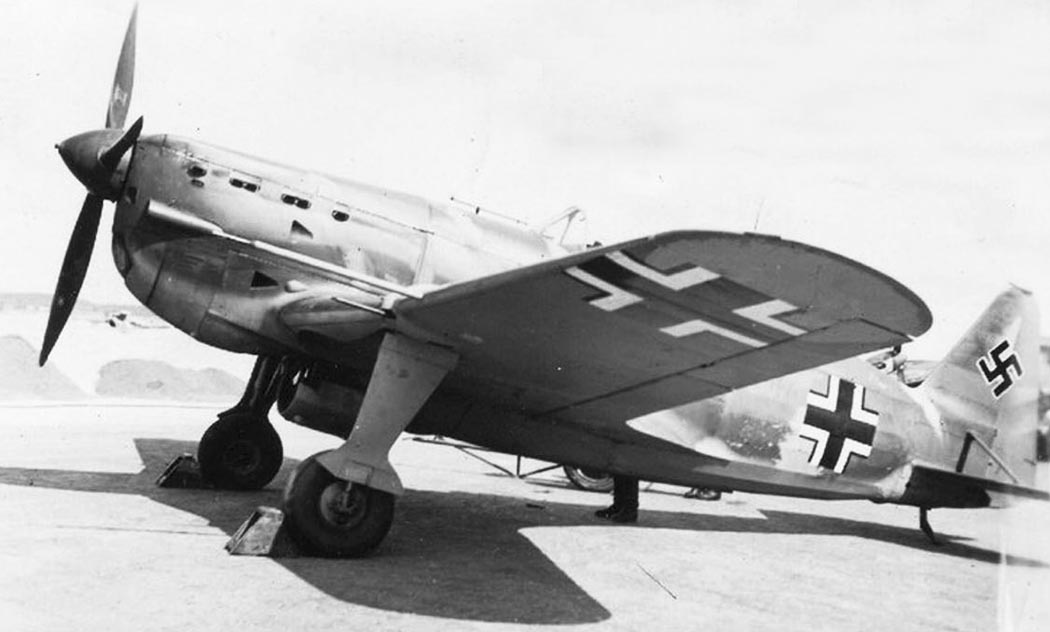Morane-Saulnier M.S.406 In German Service
Following the collapse of France in June 1940, large numbers of French aircraft fell into German hands, among them several hundred Morane-Saulnier M.S.406 fighters. Though obsolete by 1940 standards, the M.S.406 represented a substantial asset to the Luftwaffe and the German occupation authorities, both as a source of spare parts and as a training and liaison platform. The type went on to serve under German control in multiple capacities, including Luftwaffe auxiliary use, collaborationist and satellite air forces, and even in conversion programs that produced new aircraft types for Axis allies.
The Germans captured approximately 300–350 M.S.406 and M.S.410 fighters in various states of repair after the French armistice. Many were concentrated at airfields in occupied France and in North Africa. The Luftwaffe had no intention of deploying these aircraft for front-line combat, as their performance was inferior to that of even early versions of the Messerschmitt Bf 109. Instead, the Reichsluftfahrtministerium (RLM) designated a portion of the captured Moranes for second-line duties—training, communications, and evaluation—while others were transferred to Axis-aligned nations such as Finland and Croatia.
In Germany proper, several M.S.406s were delivered to Rechlin, the Luftwaffe’s primary flight test and evaluation centre. Here, engineers examined the aircraft’s construction, Hispano-Suiza 12Y-31 engine, and armament configuration. Particular attention was paid to the Morane’s mixed metal-and-wood construction and its engine-mounted cannon, which fired through the propeller hub—a feature also employed in German fighters. These technical assessments contributed to comparative design studies within the Luftwaffe’s development bureaus.
The majority of captured M.S.406s, however, were distributed to Germany’s allies. Beginning in late 1941, Germany transferred around 57 aircraft to Finland. These transfers were accompanied by shipments of spare parts and limited technical assistance. Other airframes were sent to the Independent State of Croatia in 1943 for use by the Zrakoplovstvo Nezavisne Države Hrvatske (ZNDH). Both nations operated their Moranes actively in front-line roles against Soviet and partisan forces, extending the type’s service life far beyond its French origins.
Within occupied France, the Germans authorized a limited number of M.S.406s to be retained by Vichy air units, particularly in North Africa and the Levant. These aircraft, though nominally French, were under Axis supervision and restricted by armistice agreements. Several later saw combat against Allied forces during the 1942 Anglo-American landings in North Africa, before being destroyed or captured.
In Germany itself, a small number of airframes continued in use as advanced trainers or “hack” (liaison) aircraft, particularly within flight schools and maintenance depots. The Luftwaffe appreciated the Morane’s forgiving flight characteristics and reliability for basic training, even if its performance was modest.
The M.S.406’s indirect German service also extended to industry. The Eidgenössische Flugzeugwerke (E.F.W.) in Switzerland, which had produced the type under license as the D-3800, corresponded with German authorities after 1940 regarding spare parts and maintenance support, as Germany controlled Hispano-Suiza engine supply lines. In occupied France, the Morane-Saulnier company was placed under German oversight and used for component production, including maintenance of surviving M.S.406s used by Axis partners.









